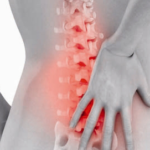How is a protrusion of the lumbar spine treated?
Protrusion of the intervertebral discs of the lumbar spine is a disorder associated with a complex of degenerative-dystrophic changes in the bone and cartilage tissue. Such a diagnosis is a harbinger of severe pathologies in the lumbar region, and more often it is a hernia. What is a protrusion? This is a protrusion of the disc into the spinal canal by 1-5 mm, which is accompanied by degenerative changes, that is, a microcrack appears.
Protrusion of the lumbar spine is diagnosed more often than others. This is due to the fact that the lower segment takes on the greatest load during almost any movement and during physical activity.
Protrusion of the discs of the lumbar spine does not require surgery, but whether it can be cured with conservative methods will become known after a series of studies and an assessment of the response of the pathology to the treatment used.
In the pathology of the lumbar and sacral spine, mild symptoms will disturb, which for a long time can be ignored due to their rarity. But over time, there is an even greater bulging of the intervertebral discs, and at any moment the fibrous ring of the disc can rupture. As soon as the protrusion of the lumbar discs turns into a hernia, the patient needs constant monitoring by a specialist, because this disease threatens with life-threatening consequences.
Why does protrusion occur?
The causes of disc protrusion are similar to those that lead to osteochondrosis and hernia:
- lack of movement, hypodynamia, sedentary work;
- excess weight, which increases the load on the back, and reduces muscle volume;
- transferred (not completely cured) spinal injury;
- surgical intervention;
- pathological posture, curvature or deformation of the spine;
- metabolic failure, metabolic disorders;
- infectious diseases;
- involutional changes (natural aging, disc wear).
The risk group includes people aged 30-45 years, involved in active sports, hard physical work and intellectual (devoid of activity). In old age, disc protrusions are detected even more often, because by the age of 60-65 years, the spine suffers a lot of various injuries, in addition, systemic diseases also affect the development of the pathology.
In children, protrusion of the intervertebral discs of the lumbar spine is extremely rare, because the child's body is still developing, the tissues are rapidly forming and have not yet had time to weaken.
stages
Protrusion of the discs of the lumbar spine is formed in several stages:
- Changes in the structure of the disc, its bulging into the spinal canal. The nucleus pulposus of the disc begins to deviate to the side, pressing on the fibrous ring, causing a bulge to form. Already at this stage, some people experience pain during movement and physical work.
- Prolapse, an increase in the bulge of the disc. At this stage, the bulge increases, symptoms such as pain, burning, constant discomfort in the lower back begin to bother. When protrusion of the sacral spine develops, disorders from the work of the pelvic organs join.
- Directly protrusion, bulging of the disc by 1-5 mm. Pain in the back and legs is disturbing, swelling of the tissues appears, sometimes numbness of the skin is observed.
How to determine
The disease is asymptomatic for a long time. The patient is rarely bothered by mild pain that accompanies sudden movement and heavy lifting. Without x-rays at this stage, it is impossible to determine the pathology. When the disc protrudes significantly (by 2-5 mm), specific manifestations already appear.
Symptoms of protrusion in the lumbar and lumbosacral region will be:
- limited mobility, stiffness in the lower back;
- muscle weakness in the arms and legs;
- periodic numbness of the skin of the limbs and back;
- the appearance or intensification of pain during physical work;
- chronic fatigue, apathy, sleep problems;
- radiculitis;
- burning pains;
- dysfunction of the bladder and intestines (rarely).
Symptoms of protrusions in the lumbar region will also depend on the form of pathology. They are distinguished, depending on the direction of the protrusion of the disk. The protrusion can be directed to the center, forward, backward and to the sides.
Central protrusion is formed near the spinal canal. Her prognosis is favorable, and she does not require surgery. Lateral located on the right or left side of the spine. With this form, deformation of the spinal root often occurs. Posterior protrusion is directed away from the abdominal cavity towards the spine, and is often accompanied by dysfunction of the pelvic organs.
Diagnostics
To confirm the diagnosis, the patient is prescribed magnetic resonance therapy. Unlike x-rays, MRI allows you to see even the slightest changes in the intervertebral disc, respectively, treatment will be started earlier. An alternative option would be to perform a CT scan, but CT only shows the condition of solid structures (bones).
How to treat
It is possible to cure protrusion of the lumbar region, but in reality it is only at the stage of degenerative disorders. When there is a strong protrusion of the disc, no medications and procedures can return it to its normal shape and structure.
Necessary therapeutic complex:
- Anesthesia - painkillers, massage of the lumbar region are prescribed, and with a strong pain syndrome, a blockade is indicated.
- Physiotherapy exercises - a set of exercises is selected by a doctor, but they can be performed at home, as well as in a special center.
- Elimination of muscle spasm - exercise therapy, manual therapy, massage, physiotherapy.
- Elimination of inflammation - non-steroidal anti-inflammatory drugs are taken.
conservative methods
Non-surgical methods of treatment of spinal protrusions:
- Medications. Shown during the period of exacerbation of the disease. Means are prescribed to eliminate pain and relieve inflammation.
- Spinal traction . The goal will be to increase the space between the vertebrae and reduce pressure on the diseased disc.
- Manual therapy. Performed to restore the position of the vertebrae.
- Acupuncture . Non-traditional methods are used as auxiliary for the general improvement of the body.
- Mud therapy (applications and baths) . They are carried out in order to accelerate blood flow, to eliminate muscle spasm and improve the regeneration of damaged tissues.
- laser therapy . Exposure to a laser contributes to the normalization of metabolism, which is extremely important for protrusion. The technique is effective at the initial stage of the pathological process.
- UHF (shock wave therapy) . The technique helps patients with impaired posture. The technique helps to align the spine, which reduces pressure on the roots and increases muscle tone.
Indications for surgery:
- persistent pain syndrome, which is not eliminated by conservative methods;
- the rapid development of the disease with an increase in symptoms;
- protrusion of the fibrous ring with the risk of squeezing the nerve roots.
Complications
Protrusion without treatment ends with a herniated disc. This disease is characterized by a violation of the integrity of the fibrous disc and the pulp going beyond it. This is dangerous because the gelatinous body, migrating along the spinal canal, can damage the spinal cord.
The protrusion does not always end in a hernia, but chronic pain may occur. This symptom will intensify with a change in body position, when the convex part of the disc begins to put pressure on the spine.
Recommendations for prevention
To maintain the health of the intervertebral discs, vertebrologists recommend:
- alternate physical work with mental work, do not overwork;
- sleep on an orthopedic mattress;
- get rid of excess weight;
- watch your posture, do not slouch;
- choose a sport that will be beneficial and enjoyable.
Almost everyone has protrusions of the intervertebral discs after 30 years. It is impossible to completely eliminate the risk of this disease, because the factors are genetic predisposition, trauma, physique, that is, something that is either difficult or impossible to control.










